|
The Home Guard & Evacuees' Page
| |
This
page owes its existence largely to Steve
Horner who through dedication and
extensive research has unearthed
photographs and information covering
wartime activity in the area.
Several of his very interesting Yarcombe
Voices articles, quoting several local
and not-so-local residents, are reproduced below.
This includes articles received from
Frank Weekes (NZ) and Tony Bees
(Australia) who share their wartime
memories with us. Further Voices articles are also
included, with thanks to Miranda Gudenian, the editor.
Thanks also to John Salter for supplying
some of the names!
There are also some interesting
documents supplied by Will Rich, some of
which are from the years between the two
World Wars.
E company
19th (Seaton
Battalion)
Home Guard
|
|
|
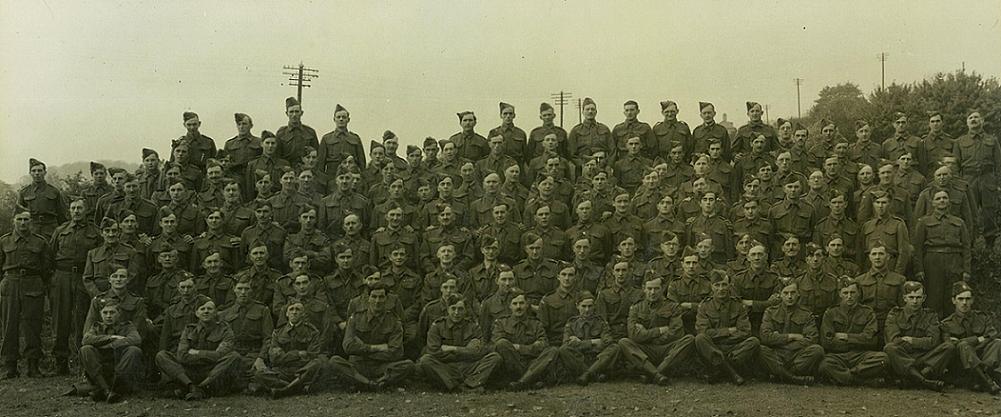 |
| |
|
| |
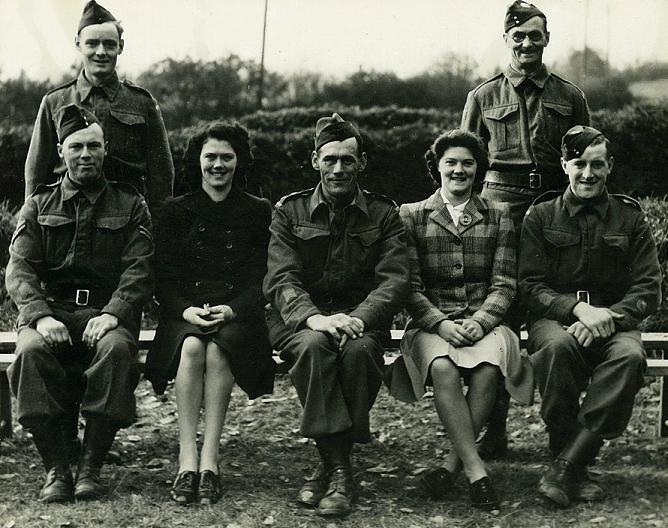 |
|
| |
|
|
| |
Front
row: Dorothy and Jim
Miller (r) |
|
|
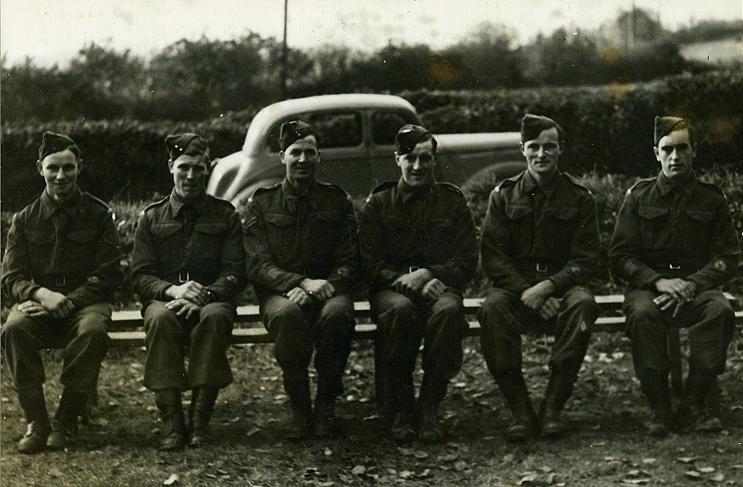 |
|
|
| |
|
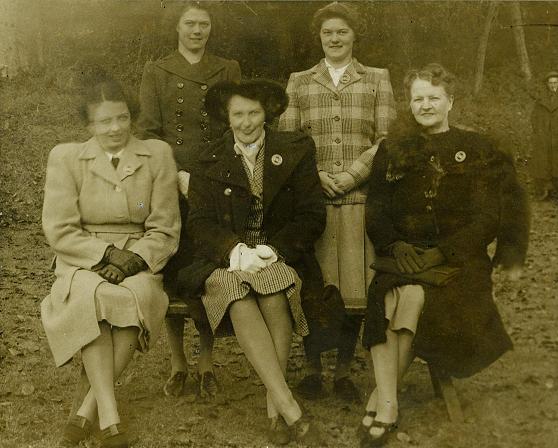 |
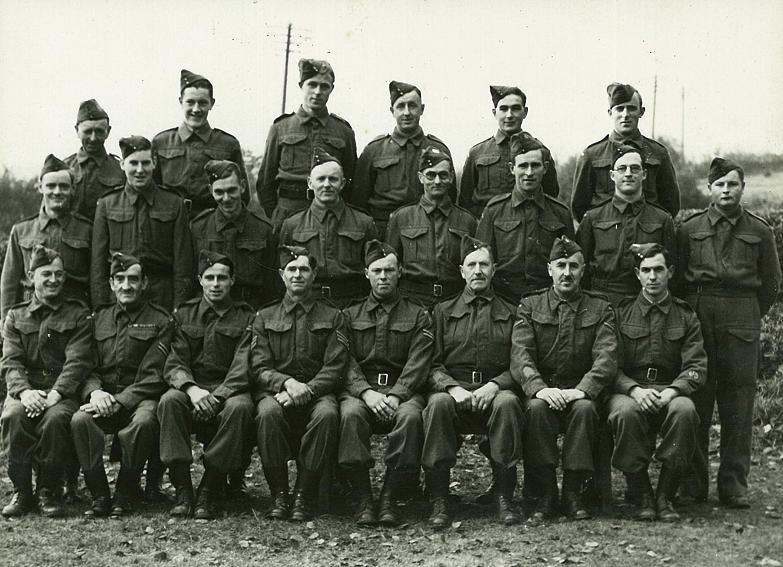 |
|
|
| |
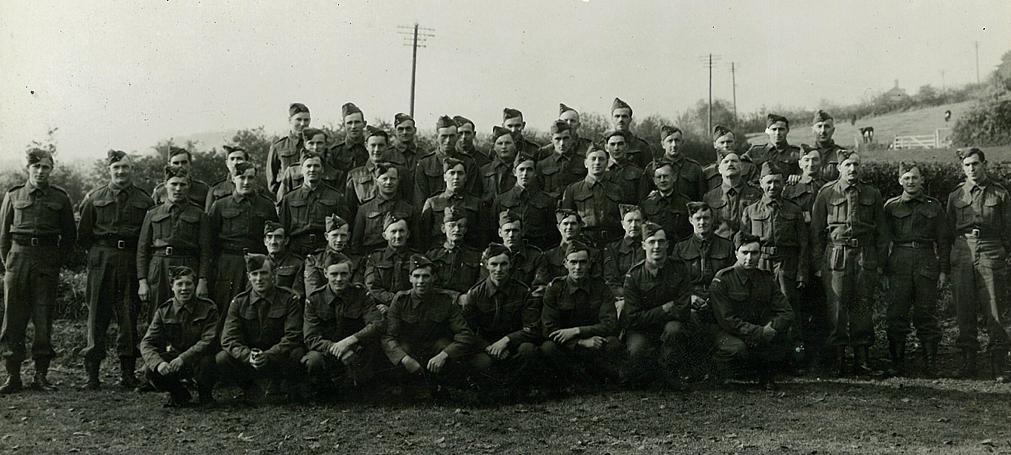 |
| |
|
|
|
|
Robert Rich |
Jessie Jeffery |
Reg Hatcher |
Harry Goodland |
Bill Podbery |
Ed
Harris |
Jack Chaplin |
|
|
|
|
|
|
|
|
Livenhayes Fm |
N
Waterhayes Fm |
Founders Fm |
Drakes Arms Fm |
Rosshayne Fm |
Lr Pithayne Fm |
Knightshaye Cot |
|
|
|
|
|
|
|
|
|
|
|
|
|
|
|
|
|
|
|
|
Donald Parris |
Ralph Salter |
? |
? |
Reg Hutchins |
Allan Miller |
Fred Quick |
Leonard Wyatt |
Jack Turner |
Bill (Boy) Doble |
George Wakely |
Charlie Bennett |
Percy Clarke |
Webster |
|
Blackhayes Fm |
Panshayne Fm |
|
|
Williambere Fm |
Liuggs Fm |
Stout Mills |
L
/Moorhayne |
Clifthayne Fm |
Stonehalls Fm |
Pounds Fm |
Moxhayes Fm |
Hillhoudr Fm |
Hilltop |
|
|
|
|
|
|
|
|
|
|
|
|
|
|
|
|
|
|
John Hodge |
Jim Miller |
Jack Anning |
Frank Denning |
Percy Searle |
Roy Cross |
Donald Denning |
Fishy Drew |
Fred Clarke |
Sammy Hurford |
|
|
|
|
|
Stout |
Croakham Fm |
Watchford Fm |
Woodhayne Fm |
Birch Cott |
Elscombe Fm |
Foxenholes Fm |
Marsh |
Smokey House |
Birch Mills |
|
|
|
|
|
|
|
|
|
|
|
|
|
|
|
|
|
|
|
William Sparkes |
Frank Bond |
Will Harris |
Major Vellacot |
Fred Mogg |
Harold Shire |
Henry Derryman |
John Clarke |
Bill (Fisher) Doble |
Bill Sparkes |
Bill Phillips |
Frank Baker |
|
|
|
Village |
Hr Pithayne Fm |
Lr Pithayne Fm |
Broadley Hill |
Sheafhayne |
Pounds Cott |
Peterhayes Fm |
Shutlands Fm |
Stoneshells Fm |
Marsh |
Tillary |
N
Waterhayne Fm |
|
|
|
|
|
|
|
|
|
|
|
|
|
|
|
|
|
|
|
|
Walter Townsend |
Reg Burrough |
Howard Turner |
Frank Chaplin |
Cecil Spiller |
? |
Leonard Phillips |
Bill Culmstock |
|
|
|
|
|
|
|
Northams Fm |
Hay Fm |
Clifthayne Fm |
Newcott |
Littledown Fm |
|
Village |
Grovewell |
|
|
|
|
|
|
|
|
|
|
|
|
|
|
|
|
|
|
|
|
|
|
|
|
|
|
|
|
|
|
|
|
|
|
| |
|
.jpg) |
.jpg) |
|
|
|
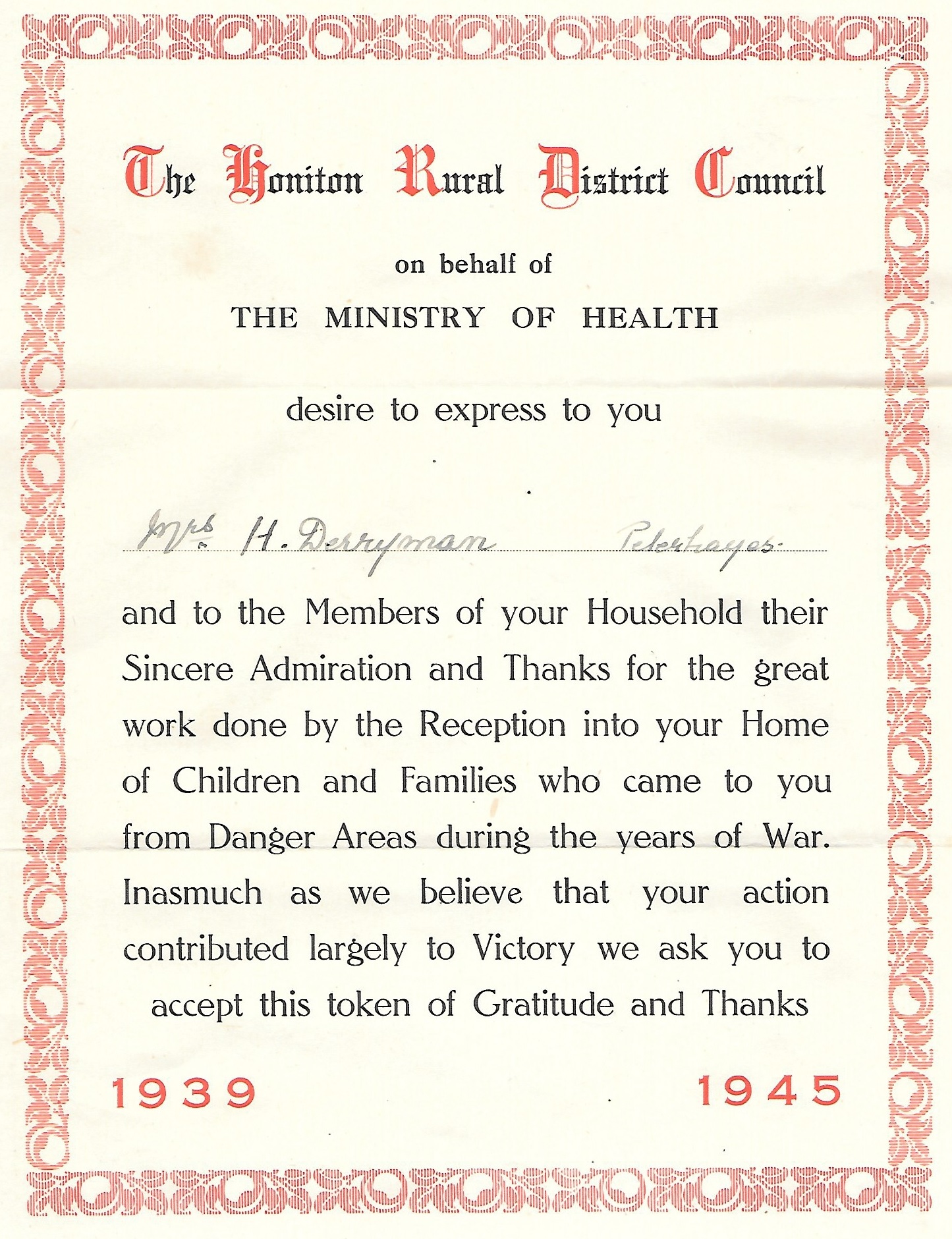 |
Thanks to Will Rich for the
1931 Deanery Magazine
extracts above, the document left (Certificates
of thanks)
and also this 1941 letter to
Henry Derryman, below
(click to enlarge in a
separate window)
See more from Will Rich in
Ancestral Search 72 |
Evacuees
|
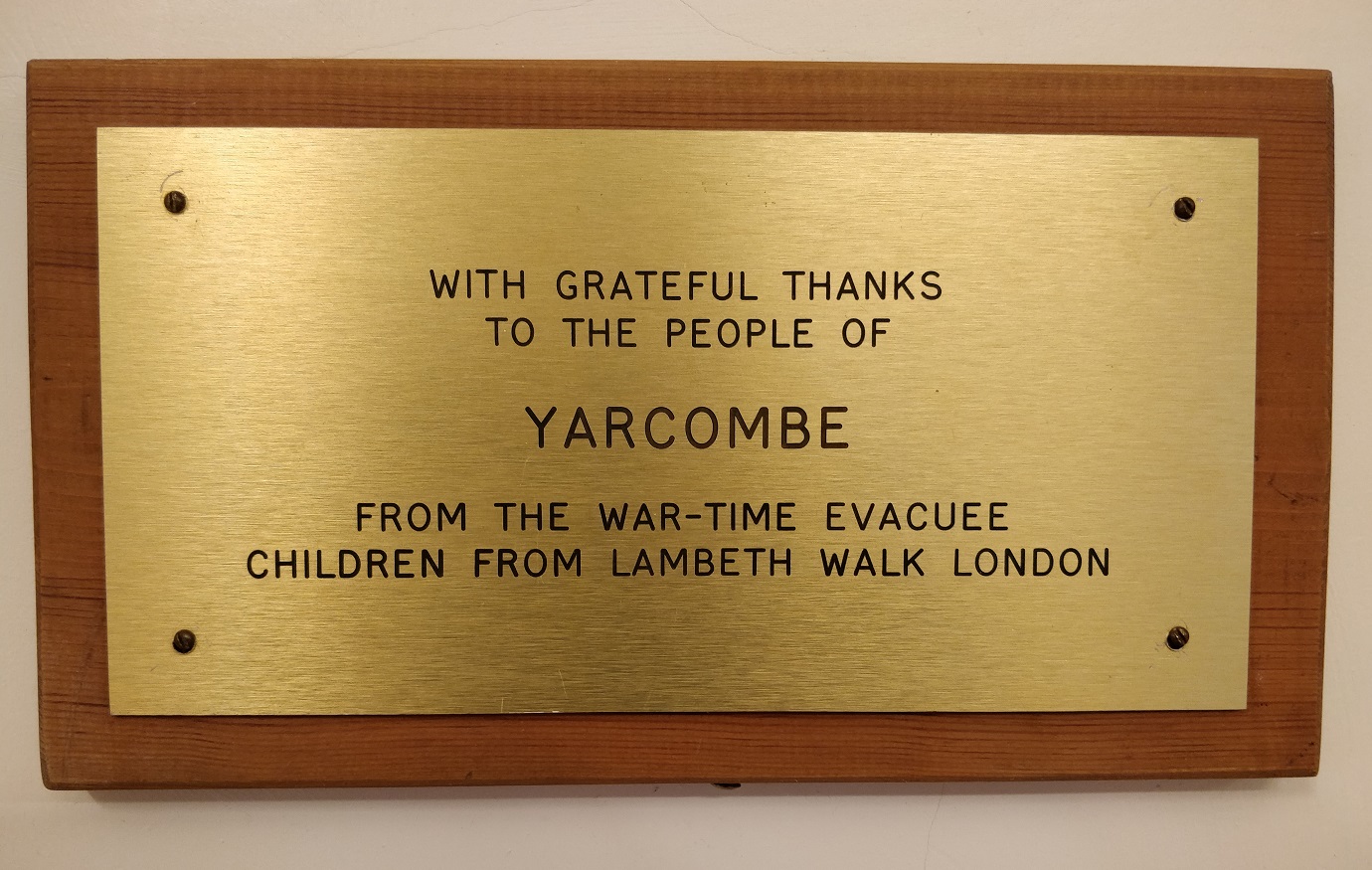 |
| |
|
Plaque on
display in the Village Hall
|
| |
Evacuees at Woodhayne
From time to time there has been
mention in The Yarcombe Voices
of war time evacuees who have
returned with their families to
the parish and Phyllis Denning,
daughter of the last tenant
farmer at Woodhayne, had told us
that there were two families
billeted on the farm during the
war. It was
therefore to our great delight
and interest that at Easter we
were visited by Maureen
Lawrence whose cousins, the
Leatherbarrows had been
evacuated to Woodhayne.
During the second World War when
Hitler’s Luftwaffe was
inflicting terrible damage to
the civilian population, more
than three million children were
affected by evacuation from
their homes, but there was no
such thing as a typical evacuee
and every single experience was
different.
Essentially there were three
waves of evacuation in Britain.
The first was in September 1939
when 1.5 million children were
moved from the major cities to
the countryside in the space of
three days. The second wave
came after the defeat of France
in 1940 when, in response to the
threat of invasion, over 200,000
were moved from the coastal
towns. The third wave, affecting
one million, came in March 1944
when flying bombs-or doodlebugs
as they were nicknamed
threatened London and the south
of England.
When reviewing these numbers it
must be remembered that evacuee
children often drifted back home
when the danger seemed to have
passed, so these numbers are not
necessarily cumulative
The Ministry of Health was the
responsible authority for the
evacuation process nationally,
but their records do not include
details of what happened in
reception areas. There were no
national records ever compiled
of this great movement of our
people. Host
families were paid ten shillings
a week if they took in one
evacuee and eight shillings and
six pence a week for each
evacuee if two or more were
taken in plus the child`s ration
book. They were issued with a
payments book and the money
could be drawn from the local
post office. Parents of
evacuees were required to pay
the money to the local council
in their area in full, those who
could not afford it were means
tested.
Every parish or district was
required to appoint a billeting
officer whose duty it was to
find billets for every evacuee,
to visit them regularly and deal
with any problems .The Billeting
Officer was required to maintain
a register which recorded the
name of each evacuee, their date
of birth, name and address of
parents, date of arrival and
departure and the address where
they were billeted.
Unfortunately not all these
registers still exist, in some
instances they have been
deposited in a public records
office or they remain hidden
away and forgotten in someone’s
house.
All evacuees were required to
attend school and in some
instances these school records
have been preserved and are a
useful source of information.
In fact the records for
Bishopswood school which was
attended by Yarcombe families
living north of the A303, are
to be found in the Somerset
Records Office while the records
of Yarcombe school seems to
have been lost by the Records
Office in Exeter. |
|
|
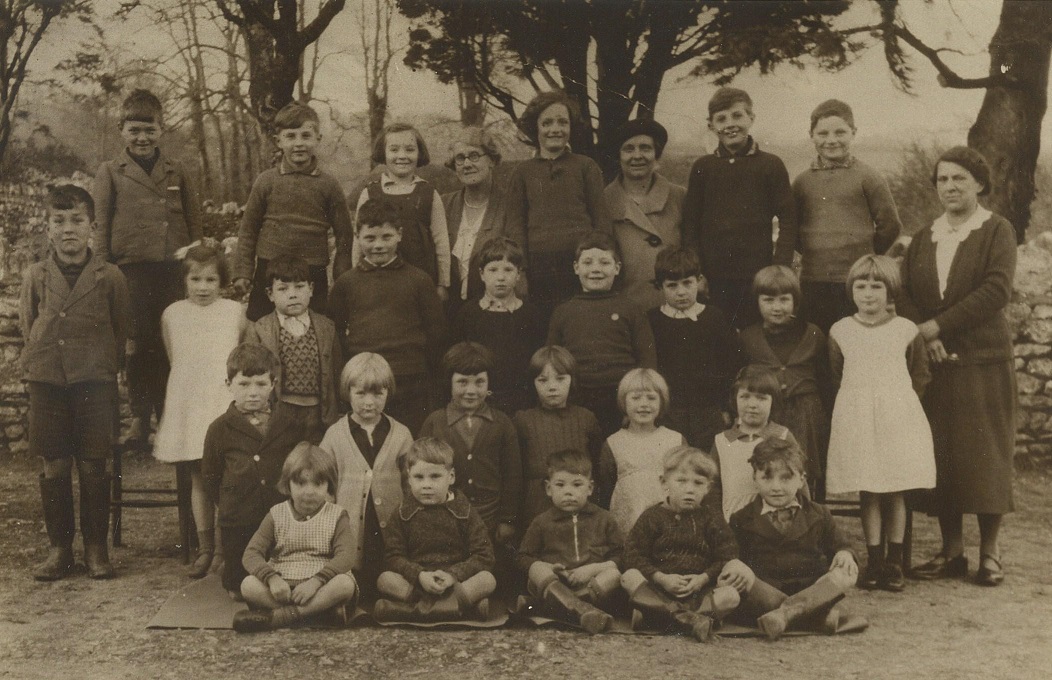 |
|
A
photograph of the class believed to be
evacuees from St Anne's Roman Catholic
Primary School, Lambeth, probably dated
Autumn 1939.
Back Row:
David Crump, _, Olive Druid, Miss
Stringer, Nellie Williams, Teacher, Bill
Webb, Patrick Sullivan.
2nd Row:
Fred Crump, Rene Bates, Michael
Sullivan, Ronald Wood, Peter Sullivan, Georgie Wood, _, _, Jean Crump.
3rd Row:
_, Sheila Ellis, Nellie Sullivan, Lily
McCartney, Ann Murphy, Pat Adams
Front
Row: _, _, Donald Adams, Charley
McCarthy, John Slattery |
|
| |
|
|
|
| |
With the
help of Phyllis Denning whose father
lived at Woodhayne at that time, and a
subsequent visit to the local Somerset
Count Record Office I have been able to
piece together this fascinating part of
our Parish history with some accuracy. It began with a George Denning who
built Hawthorne House on Bishopswood
Hill in 1879, and whose family lived
there for the following seventy years. This house is on the right hand side
going uphill some 200 yards above the
Candlelight Inn and is a substantial
brick house built in the Victorian style
and must have been one of the first
solid houses in the village which stood
out amongst the chert stone cottages
which surround it.
But
having set the scene, back to the main
plot of the story; Maureen Lawrence
explained that in the first wave of
evacuees from London her Grandmother Ada
Caroline Leatherbarrow and her sister
Minnie Finch had been billeted on
Herbert (Herby) Denning and his wife at
Hawthorne House. Now Herby
worked for his brother Frank Denning and
his wife Millie who had taken the
tenancy of Woodhayne at Michaelmas 1937
and had at that time three children
Phyllis Roy and Ron.
It
transpired that one day Millie Denning
was visiting Herby at Hawthorne House
and in passing asked the two evacuees
Ada and Minnie if they knew any one else
who might like to come and live in the
safety of the countryside. The upshot of
this enquiry was that Ada put forward
the name of her daughter Ivy
Leatherbarrow and her children Dennis
aged 6 and Pam aged 18 months all of
whom in due course who came to live at
Woodhayne. The Denning family already
had two evacuees from Bristol living
with them who were called June and John Pople, later in the war their younger
sister Millie also joined the
household.
Today it
seems quite amazing how 5 Dennings plus
3 Leatherbarrows plus 3 Poples all
fitted into the house, and how ”Aunt
Millie and Uncle Sonny” as their new
family called them coped with the
influx. Doubtless extra hands helped
with the farming chores but it must have
been a huge effort undertaken with
patience and cheerfulness. All accounts
we have heard speak only of happiness
and wonderful recollections.
The
families remained firm friends and after
the war the Leatherbarrow family, which
included Maureen Lawrence all visited
Woodhayne on holiday from London on at
least three occasions and returned home
laden with produce from the farm at a
time when all food was till strictly
rationed. The Poples from Bristol all
enjoyed the countryside to the extent
that all married into local farming
families.
Maureen
arranged for me to be sent some charming
photos from both the war years and their
holidays after the war. This series of articles
will then be preserved for future
generations which will remain record for
posterity as these memories have down
been written down before they are
forgotten in the mists of time.
I am
hoping that if anyone does have other
names or recollections of this important
part of the history of our Parish that
they will send them to me or the Editor.
I can be
contacted on 01460 234342
Steve@horner.uk.com
|
|
| |
Evacuees at
Woodhayne - a personal reminiscence
In
previous paragraphs about Evacuees in
Yarcombe I explained that we had been
visited over the Easter holiday by
Maureen and Dennis Leatherbarrow whose
family had been billeted at Woodhayne
during the last war. Since then research
has continued apace, with much interest
being shown by people who have contacted
me with offers of help, Frank Weeks who
now lives in New Zealand and who is a
great fan of Yarcombe has helped
considerably and I am now in contact
with his cousin Quentin Newman who lives
locally. Shirley Briant has provided
some wonderful photos, letters and
memories and told me about Ronnie and
George Wood who came to the parish from
Lambeth, a sad tale, because shortly
after they returned home, they went to
visit their grandparents and when they
returned they found their own home
flattened by German bombs which had
killed their parents; Quentin Newman who
is a good friend of Shirley, she
describes him as almost a brother, has
already started to try and find these
Wood brothers by making contact with a
South London newspaper “where are you
now” column, and of course the
indefatigable John and Barbara Salter
have unearthed a quantity of information
and a picture of the evacuees and their
teachers; it will take me some time to
sort and correlate this treasure trove.
However, back to the evacuees at
Woodhayne, I received the following
e-mail from Dennis Leatherbarrow which I
have decided is worth publishing in the
form below, it is very evocative and
sets the scene only as his words can
describe the situation in those hard
times; I have also annotated where
necessary:
Maureen gave me your
Email address so I could get you updated
on how we we got to know "Woodhayne
Farm" & grown to have as part of my
early childhood and lovingly always
remembered. Let's start at
the beginning shall we?
My Nan & her sister were
evacuated to Bishopswood village, they
lived in the house (1) next to the
General Store & Post Office. which was
near the village school.
They lived with who we called Aunt
Doreen & Uncle Herbie, (2) who worked
full time on Woodhayne for Mr &Mrs
Denning. It was mentioned
that they would like to have a family
from London as evacuees, so Nan said she
will ask my Mum & Dad if they would like
to go there, so in the middle 1940 we
arrived there Mum, my sister Pam (18
months old) plus me @ just six years.
From the word go, we were treated as one
of the family & warmly welcomed from
Uncle Sonny, Auntie Milly, daughter
Phyliss, then Roy & Ronnie, Little Kay a
few years later.
My very first impression
& memory of Woodhayne was when we
arrived it was pitch dark, the house was
lit with oil lamps and candles, it was
such a warm feeling. Mr
Whynslade (3) picked us up from Taunton
Station, I suppose he was the village
minicab service in those days!
We used also to go to him to get Uncle
Sonny's wireless battery to be charged
(a big heavy thing in a glass case)
He
would give us another in replace charged
up. The wireless was only used for the
daily news & weather forecast, so as not to
use up the battery too quick!
There were two shops in
the village, the Post office and off the
main street in the village was the
bakery, I cant remember the name, but
the baker (4) was also the carpenter in
the village, so he even became the
Undertaker when required! I
cannot ever recall his services ever
needed. I should imagine his services
were used but us kids weren't told of
such things.
All the evacuees went to
school in the village hall, (does it
still have the corrugated roof?) (5) We
didn't school with the locals, they had
their own school. We were
all different ages, so the teacher had
to cope, I just don't know.
All children were kept together for
Sunday School always dressed in our best
clothes.
The local farms nearby
"Fox & Holes" you went through the
forest by the "Northfield" Uncle Don (6)
had that farm, related to Aunt Millie I
think, the other farm we went through
the quarry to "Whitebarn" (7). Also related to Aunt Millie, the old
gentleman who lived with his family was
known as "Old Drake". As you
might know Sir Francis Drake owned quite
a lot of land around the Yarcombe Parish,
the family were connected with him as I
was told they have connections with the
Drakes Drum Relic.
From the war, we met the
Americans training on the common by the
crossroads for Honiton, Churchinford &
Taunton. They use to spoil
us kids rotten, sweets chocolate
cigarettes to give to the adults.
One GI asked my mum if he could adopt my sister Pam. Mum said not for a 100 fags! Do you still have that lovely apple
in the Orchard? It was called "Plum Viney" shaped just like the name a large
Plum (8). It was 3/4 down the orchard on
the left aside by the field. I've never
tasted a better apple!
I hope you like the update
given if any more memories come to mind
I'll send them onto you with photos from
my sister Pam to come.
Best regards, from
Dennis Leatherbarrow (Maureen's cousin).
Notes
1.
Hawthorn House on Bishopswood Hill built
1879 by George Denning
2.
Herbert Denning
3.
The
Winslade family still live in Beechcroft
at the top of Whatley Lane Bishopswood
4.
Mr
Sumption ?
5.
The
old Bishopswood hall was indeed a
corrugated iron building
6.
Don
Denning
7.
Coburns ?
8.
Sadly it no longer
exists, but is this a local variety of
apple ?
And just
to finish a Post Script from Dennis
following further correspondence with
him:
You mentioned us crossing the county
borders while travelling to school.
That was my first lesson to learn at
school. Also walking to
school in the snow and falling into the
drifts getting ringing wet.
When arriving at school all our clothes
taken off, putting a blanket around and
sitting around the the big old stove
like they have in the army barrack room.
So snow is only nice on Xmas cards as
far as I'm concerned, how people pay
money to wallow in it I just don't know!
Uncle Sonny kept about twenty Devon
Shorthorns for milking, William the
Bull, also about a dozen Heifers, always
about 6 calves a season. The
bull gave service to a lot of the local
farmers cows, they use to come from
quite a distance at times. so you can
imagine, at a very early age we kids
soon learnt the facts of life very
quickly! |
|
| |
|
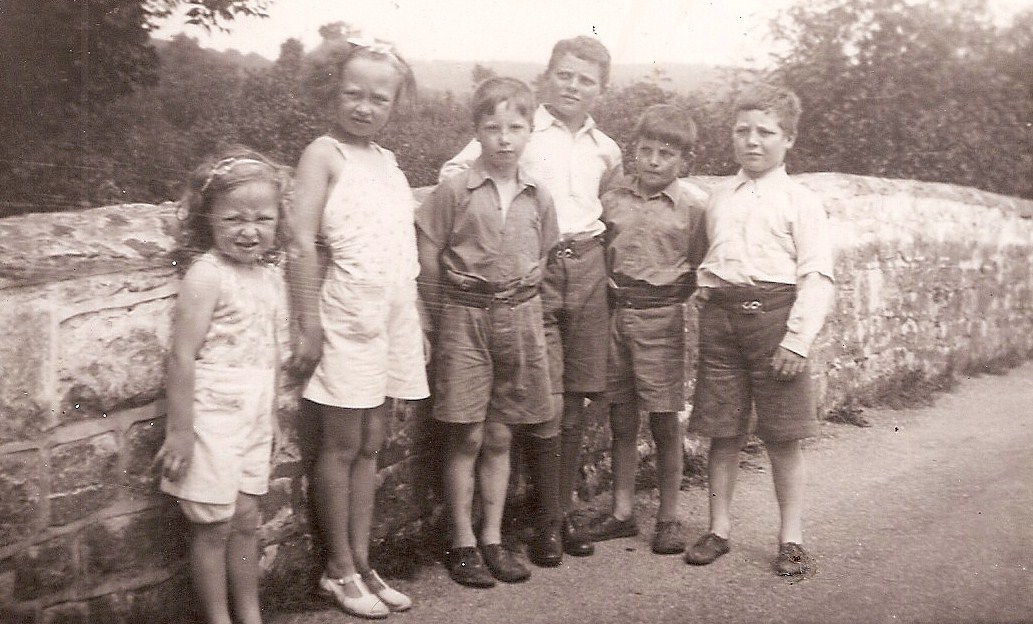 |
|
| |
|
|
|
| |
Broadley Farm
Evacuees -
Reminiscences from Marian Rich
Mrs
Florence Shelston (Flo or Florrie) to
her children Wendy, Marian Anthony and
Christopher, born during the war, known
as Auntie Shelston; her husband was
Harry (Shelly to men on the farm)-Uncle
Harry to children. At first
Mrs Shelston went to another home in the
parish but wanted somewhere with an
underground cellar. Broadley
has an underground cobbled cellar, it
has access via inside and outside steps;
it was a dark unlit space with a few
hogsheads of good cider and rabbit
skins hanging up to dry.
If she
heard a noise Mrs Shelston would shout
“The Jerries are coming “became agitated
and dash for the cellar door.
This fear was real and frightening to
her as her London home was bombed twice
and later – to make things worse the
hospital she was in was bombed.
She had shrapnel damage to her face and
was slightly disfigured. I believe Mrs
Vera Rich took her in the tiny dark
green Austin Seven to Exeter Hospital.
I went to Exeter and saw the terrible
bomb damage as well as crocus growing by
the Cathedral.
As Mrs
Shelston recovered she took to pushing
the pram with either Wendy Anthony or
Chris to Pladford, she fondly called the
little stream “our seaside”; she recited
London street cries as well as nursery
rhymes - I recall only one “Cod Haddock
or Plaice”. She talked about
going “hopping in Kent”. As
a girl she had been in the Girls
Friendly Society and later The Primrose
League.
There was
no telephone so she wrote several
letters to her family, she had very
clear distinctive handwriting, and
sometimes she packed up a parcel with a
fresh rabbit and sent it to London.
I believe she also sent a moss filled
box with violets and primroses every
spring.
If her
family came they shared a bedroom and
the men had a straw mattress on the
floor. Harry Shelton stayed
in London an was a train driver, he sent
the sepia printed London railway
magazine regularly. When
visiting Harry loved eggs and couldn’t
wait to have several for breakfast.
It was quite a shock to them to see a
hearth-oven fire as well as paraffin
stove for cooking, all the lamps were
oil or Aladdins, and on the farm
hurricane lanterns were used in the dark
outside.
We all
had plenty of good food, wild rabbits
were everywhere, hens and pigs were
killed regularly. There was
usually a ham in brown paper hanging up
in the chimney, bacon in the kitchen
bacon settle and pork in the brine tub
kept in an upstairs store room.
This room also had apples in winter and
chitting potatoes in the spring.
Homemade cheese was also a real luxury.
There
were three apple orchards for eating
cooking and cider apples; crab apples
grew on a few farm hedges as well as
blackberries and on the hill hedges
there were wortleberries. In
late summer there were plenty of
mushrooms. Peas and potatoes
were grown in the fields as well as in
the family garden; rhubarb raspberries
gooseberries and blackcurrants were all
plentiful. In the front
garden there were three plum trees as
well as one on the south facing house
wall. There were hazel nuts
in the farm hedges walnuts on the tree
in the mead as well as sweet chestnuts
from Blackhayes goyle for winter
storage.
The
Shelstons were family friends and were
still in contact when they retired from
London to Little Clacton near Clacton on
Sea. They sent books and
toys certainly until 1960; every year
Mrs Shelston knitted suits for our teddy
bears, every Christmas a big parcel
arrived. In late summer
during the 1940s they brought bundles of
“Everybody’s” and “Illustrated”
magazines they saved during the year.
The most special gift to my sister Wendy
was a small black doll Auntie Shelston
called a piccaninny – a word never
spoken these days!
The
Shelstons enriched our lives as the farm
changed from having two horses called
“Farmer” and “Captain” to two tractors,
the first tractor was a Fordson Major –JJT
1-, then a little grey Ferguson arrived.
The farm dogs were Gryp then Nobby in
the 1940s.
I’ve
visited Aunts and Uncles at Livenhayes,
New Barn and Woodhayne.Grandparenst were
at New Barn and Shorthayne.
Shirley
Denning at Moorhayne and Margaret Hoare
at Glebe were considered special older
friends.
Looking
back so many people showed us great
kindness and generosity, thank you all. |
|
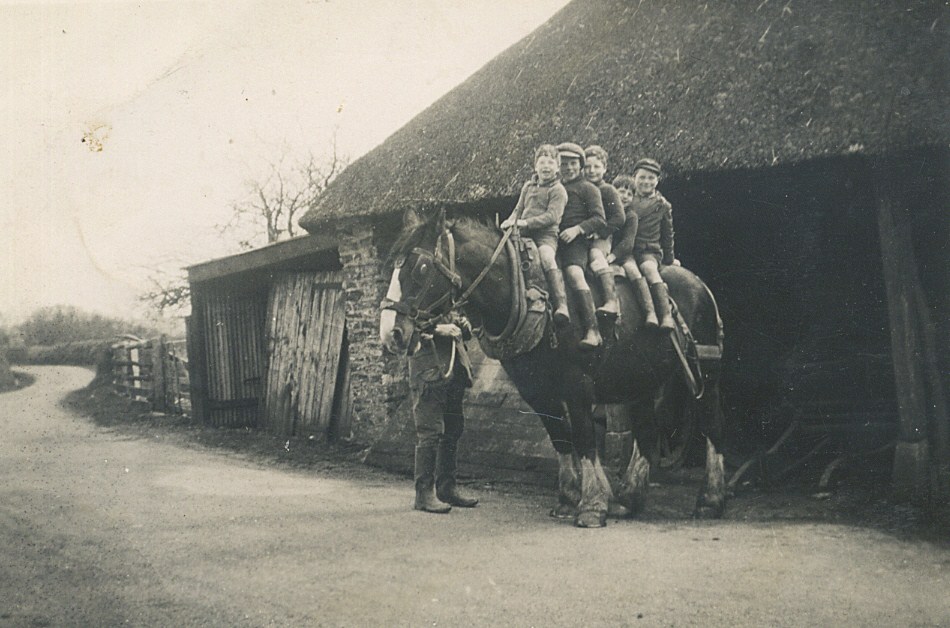 |
|
Some
of the evacuee children on a cart horse
outside a wagon shed at Lower Pithayne
Farm:
Ronnie
Wood, Michael Sullivan, _?, George Wood,
Peter Sullivan. |
|
| |
|
|
|
| |
Frank's Story
My name is
Frank Weeks. (Actually it
has Francis on my birth
certificate although I was
never christened, which
tends to give me problems
with my passports.) I was
born January sixth 1935 in a
London suburb when, unknown
to me, Hitler was rising to
power in Germany. When I was
four years old the second
World War started and the
British Government, in its
wisdom, decided that all
school children would be
safer from the anticipated
German air-raids away from
presumed targets. In
September 1939 over 3
million children with some
accompanying teachers and,
in some cases parents, moved
out of cities to the
supposed safety of the
country-side. Some went to
the coastal seaside towns on
the south coast, which was
very nice, just like a
summer holiday, until
someone realised that if
Germany invaded Britain
across the Channel these
towns would be the first to
feel the German brutality,
so these children were moved
on again.
My father,
who was a rather serious but
well educated man had
decided to make his own
arrangements and sent my
mother and myself to the
village of Yarcombe in
Devonshire.
We went and
stayed at the end house in
the village which was, and I
believe still is, called
Yarty View. Not that one
could actually see the river
Yarty from the house but it
was not very far away. The
house was owned by a Miss Tatten-Waters. (or Tatum). My father's family had
holidayed in the vicinity
for some years staying at a
farm called Middle Moorhayne
that catered for guests,
owned and run by Henry and
Dorothy Denning who had two
daughters, Monica and
Shirley.
A distant
relative on my mothers side
was a Fred Lawson, who had a
hotel called The Crown in
nearby Chard. What the
connection was by either
side of the family to Miss
Tatten-Waters I never knew.
My only recollection of our
stay with her was that I had
picked some lovely flowers
for my mother only to find
myself rather reprimanded as
the flowers were from the
pumpkin plants in the
garden.
After a
while, while Britain
experienced the so-called
Phoney War when nothing much
appeared to be happening, my
mother decide to return to
London to care for my father
and made enquiries in the
village as to whether anyone
would be prepared to care
for me. So it was
that at five years old I
went to live at Underdown
Farm, about a mile out of
the village in the care of
Coral and Rosie Clark and
the sixteen year old
daughter from Coral's first
marriage, Mary.
Coral was a
WW1 veteran and a hard
working gentle soul though
he could be stern if needed. His wife Rosie was rather
quiet and went about her
duties which as far as I
recall meant a well run
house with clean, pressed
linen and a good table. The
daughter, Mary was a pretty
but rather tubby redhead who
had a happy disposition and
a ready laugh.
Goodness know
what they thought of this
five year old lad that had
arrived in their midst. Having lived
in a modern house in London
I had to face some changes. Underdown, in 1939, had no
electricity, no phone and no
running water. Evening light
was from Tilley lamps and a
candle lit you to bed. There
was always a huge fire in
the massive fire-place which
had a system of ratcheted
hooks on beams above it that
accommodated the various
pots of cooking and could be
raised clear or lowered onto
the heat as required. Legs
of pork from the illegally
slaughtered pigs were
suspended up in the chimney
for months to make bacon. I
presume they had been well
soaked in salt water as they
were well salt encrusted and
it was the saltiest bacon I
have ever tasted.
Water for
drinking was drawn from a
slow running tap situated
outside the house fitted to
a tank in which the milk
churns were placed to keep
the milk cool until taken
away. Water for other use
was collected, rather
faster, from a stream,
'across yard' where a spout
arrangement had been
installed enabling buckets
to be readily filled. On
'washing day' being Monday,
the ladies would collect
several buckets of water for
the job in hand and had to
make sure that they did so
before the cows in their
stalls were let out. They
were let loose for a drink
while their straw bedding
was changed and, as cows do,
would walk in the stream,
upstream of the water-spout
muddying the water as they
did so. If the cows were let
out before the women had
collected clean water the
men were not popular as the
stream would take a while to
clear causing the women to
get all behind in their
work. It appears that
Tuesday was drying day and
Wednesday was ironing day
and so the week went on. Incidentally I can assure you
that starched linen sheets
on a cold night are the
coldest thing on earth.
Though there
were several Warming Pans
hanging on various walls I
can only recall them being
used very rarely. The usual
device was stone hot water
bottles. These had a couple
of drawbacks, one being that
if you stretched out during
sleep and connected with it
with a toe it was rather
painful. Secondly as they
cooled, and in fact got
quite cold people would push
them out of their bed and
they would crash noisily to
the floor. So, if one had
trouble sleeping you could
count the crashes until you
knew the last one had been
evicted.
Coral had a
radio. This was operated on
a glass battery, which I
think was called an
accumulator, which had to be
recharged occasionally. The
only time the radio was used
was for a one o'clock news
broadcast on a Sunday
followed by a farming
programme. The household had
no news papers but took The
Farmer and Stock Breeder
magazine.
As for
toilets, the ladies used an
indoor flush version but
with no inside running water
a carried bucket had to be
used to flush it. While the
men had a brief stroll to a
garden one. In New Zealand
they are known as 'long
drops' but I don't think the
term is used in England. Actually this one was 'self
flushing' as a tile pipe
line ran from the edge of
the stream, under the toilet
to rejoin the stream further
down a field. I recall Coral
having to clear water weeds
from the pipe mouth on
occasion. The current owner
of the property was totally
unaware of the system until
I recollected it to him. The
general discussion resulted
in the view that something
that had worked very well
for 600 years would not be
allowed today!
I had a
couple of chores to do about
the farm but I think it
mainly consisted of giving
the farm chickens their
daily feed, collecting their
eggs and ensuring they were
shut up at night against any
marauding fox. Their chicken
house was usually well
across a field from the
house so they were not
around the house, or worse,
in the vegetable garden.
I was enrolled
at the Yarcombe school
although with first influx
of numerous evacuees the
school-house couldn't cope
and some twenty or so of us
smaller children used the
Village Hall. Memories there
are of a teacher putting
pictures of objects on a
board and we were required
to either know the object or
even to spell it. I can only
recall the coloured
pictures. Also, and I
distinctly recall being most
indignant about it, some of
us, I presume the youngest,
were supposed to lay on cots
on the stage for an
'afternoon nap'.
I was far too
'big' for such a thing. I
eventually moved to the
schoolhouse proper under the
two lady teachers, Mrs Loft
and Mrs Pidgeon. I would walk
out to the school across the
fields sometimes meeting up
with some cousins who were
living at Moorhayne or other
children along the way. It
probably gave me my love of
the country with wild
primroses or snowdrops,
answering a cuckoo from the
copse, the birds nests with
eggs or fledglings and wild
strawberries in summer. There was the occasional
adder slithering away
through the grass and the
changing variety of crops.
The Clark
family was 'Chapel People'.
Mary and I would walk to
Chapel in time for Sunday
School. Mary was a teacher
there. We then stayed for
the main service, Mary being
the organist. I think we
children were given a homily
by Mr Ryman, the incumbent
minister, and then we went
back to the Sunday School
room while he gave his
sermon to the adults. We
then walked home to the
Sunday dinner which was
always cold as everyone had
been to chapel. It could
consist of slices of ham
followed by a brick-hard
sort of bread roll that had
to be dunked in ones tea in
order to ingest it. Sometimes we would return
later in the day for the
evening service, again
walking there and back.
All stock had
to be rigorously accounted
for on farms with the
wartime regulations but all
the farmers gave lower stock
numbers to the government in
order to kill off the odd
beast to feed their
families. If a Government
Inspector was due to come
round we children were
threatened with murder if we
were to disclose the
where-a-bouts of any
carcases buried beneath the
stacks of straw.
Sunday School
had its highlight at some
stage during the year when a
Sunday School Outing was
much anticipated with a trip
to Lyme Regis or some other
exotic seaside town. Another
big excitement was the
fortnightly trip, all of six
miles, to Chard.
Coral's car
was brought out of its
garage and left running
while we had breakfast and
he got himself ready, about
two hours. Then we would be
off at about thirty or even
forty miles-per-hour for the
day out. The ladies had
their lists of shopping to
do while Coral met up with
his cronies at the market. We kids were left to our own
devices and we would all
meet at the car at a
prearranged time in order to
return to the farm for the
evening chores.
Christmas Day
was the only day that 'front
room' was used. A fire lit
in the grate and a christmas
tree in evidence with
presents for everyone under
it. Although the milking and
usual farm chores caring for
the animals had to be done
as usual the rest of the day
was fairly leisurely until
the even chores came round
again but it was a happy
day.
I am not sure
of dates but I must have
stayed for two or more years
with the Clark family before
returning to my own who had
moved to Colwyn Bay for a
year prior to my father's
death in 1943.
I have read
and heard of many unpleasant
experiences endured by some
evacuees but I was fortunate
to have been cared for by
good, hard working, kind
decent country folk.
They led a
simple life compared to our
modern ways but I'm sure
were happy and contented
with their lot. Coral and
Rosie Clarke now lay under
the same gravestone at the
Chapel while Mary married,
had two sons and moved to
South Petherton.
After six
years at the Royal Masonic
School at Bushey (near
Watford) during which I
would often return to
Underdown for school
holidays, I eventually
worked at Underdown for a
year prior to emigrating to
New Zealand in 1952.
Tony's Story
(Received September 2016)
I have been looking at the
comments on Yarcombe, and
notice that you only have a
small part on Bishopswood.
I would like to give you
some details of my life from
1940 at age 10yrs.
There was a whole bunch of
us kids sent to the country
from Bristol, we arrived in
a bus at the large tined
roof building that we later
found out was going to be
the Evacuee school.
My younger brother and I
were taken in by a Mr & Mrs
Saturley and their brother,
who had a farm called
Woodend about 500 Yards from
the school. She
also had another couple of
kids - brothers, we never
found out where they came
from.
My sister was taken by a
young farming couple by the
name of Charley Jenner.
Their farm was up on the top
road going out of the
village towards Browndown
crossroad leading to Taunton
and Churchingford where we
went to the Blacksmiths
shop. We also
went up there and mixed with
the Yanks when they were
training. I also
used to go to the bakery as
it belonged to the
brother-in-law of the
Saturleys and his name was
Upton and he and his wife
had a daughter named Unna.
They lived in a House in a
field behind the Evacuee
school.
I had a wonderful time
living and working with the
animals. My
sister went home in two days
and my brother in about a
week but I would not go and
stayed there until 1945.
I was a sickly boy, not
good, always sick with
things but when I came home
I was a big strapping lad
and very healthy.
The Saturley's son was in
the army serving in the REME
and when he came out he took
over the garage that was
next to the village shop.
We used to walk over the
fields and stream to
Buckland St Mary about 4
Miles away. It
was a bigger village than
Bishopswood and we were in
touch with a couple of girls
there. I could
go on for hrs but time is
moving so will close if you
would like more let me know.
I have lived in Australia
for the last 35 years and am
doing well at 86yrs.
Kind regards to all
Tony Bees
Qeensland Australia
The following was extracted
from Yarcombe Voices during
2015 - repeating the series
first published in 2005:
70 YEARS ON -
Memories of Life in
Yarcombe during the
Second World War (1)
A few of us who lived in
Yarcombe during the 1939
- 45 war have tried to
record our memories of
that time. Some of us
were going to school,
others were in the LDV
(Local Defence
Volunteers) or were
wives of them - later in
the war the name was
changed to the Home
Guard.
One of the first things
we remember were all the
evacuees arriving, most
of them from the East
End of London,
accompanied by their
teachers, Miss Stringer,
Miss or Mrs Marsh, and
one other whose name we
can't remember. They
rented Corner Cottage by
the school. Our way of
life was completely
different from what they
had been used to. Mr
and Mrs Georgie
Williamson, who lived at
Rose Cottage, were the
main ones responsible
for finding places for
them to stay. All
houses that had spare
bedrooms were expected
to take children and
sometimes a parents. We
had two little girls at
Panshayne named Pat
Adams and Ann Murphy,
they were only five
years old. It must have
been very hard for
them. I remember the
first night or two we
couldn't sleep because
Pat Adams kept shouting,
"Lady, Ann Murphy wants
to go home!"
Schooling for the
children was the first
priority, local children
one part of the day,
evacuees the other. A
few of us mistakenly
thought this was a very
good idea. This went on
for a while, until the
Jubilee Hall was used as
a school; the London
children then went
there. Eventually some
of the evacuees went
back to London, so there
was room for all of us
in the school. Everyone
was issued with a gas
mask which we had to
carry to school, as well
as a dinner bag. There
were no school dinners
or school transport at
that time. All the
evacuees had to write a
letter home to their
parents or family if
they had any, on Friday
afternoons. Some of the
London boys were always
looking for a fight when
we met up with them,
they were a tough lot,
we had to learn quickly
to defend ourselves, but
on the whole we got on
pretty well together.
Mrs Gawne, the Vicar's
wife, organised knitting
parties on a regular
basis, to knit garments
and comforts for the
forces; even the girls
were expected to join
in. All the signposts
were removed in case of
invasion. The Church
and school bells were
not to be rung except if
invasion was imminent.
Everyone was told to
dive for cover if we saw
a plane with a cross on
it. Us children were
sent out with trolleys,
etc., to collect waste
paper for the war
effort. In the autumn
we had to collect
blackberries for the WVS
at Honiton to make jam
with; also we had to
collect hips to make
syrup. The bus services
to and fro from Chard
and Honiton were quite
good, about twice a
week; the royal blue
coach to London ran
every day, it would stop
to pick up anyone.
Petrol was rationed so
some means of transport
was needed.
Food and other things
were soon rationed;
sweets disappeared, also
most imports. Three
bakers came to the
Parish: Durrants and
Pidgeon from Stockland,
and Sumption from
Buckland; butcher Powell
came twice a week from
Membury. Each person
was given a ration book
which had to be produced
every time you bought
food (not many obesity
problems then). A lot
of wild rabbits were
eaten, there were
thousands of them about
and they weren't
rationed. The
Government placed a
large store of tinned
meat, etc., at Middle
Moorhayne and I believe
at other places in the
Parish, to be shared out
if we were invaded.
Farmers had to keep a
very strict record of
all they produced and
sold. They were not
allowed to sell or
supply foodstuff to the
general public.
The blackout was
strictly enforced, you
were in serious trouble
if you had a light
showing by night. In
the winter, Church and
Chapel evening services
were held in the Jubilee
Hall where it was easier
to put up blackout
curtains. On the farms
it was a problem in
winter carrying around
an old shielded
hurricane lantern in the
dark, trying to see what
you were doing tending
and feeding livestock.
Most farmers were
ordered to plough up
more fields to grow
cereals, potatoes, etc.,
failure to comply could
mean eviction. Cars,
etc., had to be fitted
with masks to deflect
light down on to the
ground, it was like
driving with just
sidelights.
All able-bodied men were
told to join the Local
Defence Volunteers or
the Special
Constabulary. The LDVs
were expected to do
night guard duty looking
and listening for enemy
activity, also groups of
men had to report for
night duty at Yarcombe
Garage; the newly built
log cabin in the little
copse at Taunton turn;
Hilltop Garage; Stopgate
and Marsh Garages - four
hours on, four hours
off. Any strange or
suspicious vehicles were
to be stopped, the
drivers questioned.
Failure to stop meant
being fired at, which on
occasions did happen.
Early in the war
drilling took place at
Sheafhayne Manor for the
LDVs under the command
of Captain Benson.
Everyone was issued with
twelve bore cartridges
and an LDV armband. The
cartridges were single
shot instead of
containing small shots,
they were only to be
used when on duty.
After a while the name
was changed to Home
Guard. Uniforms and
steel helmets were
issued as well as
rifles; also machine
guns, mortars, grenades
and other equipment for
which special training
was required. Another
of the duties the
Yarcombe Home Guard at
times had to do by night
was guard the Wilmington
end of the Honiton
railway tunnel.
Sometimes the fireman on
the train would throw
out a few knobs of coal
so that they could warm
themselves and make some
tea in the Gangers'
hut. The line leading
up to the tunnel from
the Axminster side was
fairly steep and so the
loaded trains would be
moving rather slowly.
A few bombs were dropped
in Yarcombe near Crawley
and at Northams but not
much damage was done.
Quite a few German
bombers would fly at low
height up the Yarty
valley to keep under our
radar, on some nights it
was difficult to sleep
with the noise. They
were usually heading for
Bristol, Cardiff, or
other targets around
there. An elderly man
living up at the Beacon
didn't feel safe
sleeping in his house so
he built a wood rick
made of faggots of wood
but hollow in the
middle, well away from
the house, and slept in
there.
In about 1941/2
Rottingdean Boys School
moved to Sheafhayne
Manor where they stayed
for several years.
During a gale in
December 1941 a barrage
balloon broke loose from
its moorings at Falmouth
and ended up landing in
the orchard at Panshayne,
it looked huge before it
was eventually punctured
by the apple trees.
Three or four RAF men
came in a truck to
collect it. We were
picking geese at the
time, they thought the
geese looked lovely,
some of them said would
we send some to their
families and relations
in South Wales which we
did for quite a few
years. We could have
been in trouble for this
but luckily the Ministry
of Food officials didn't
find out!
From
1942 onwards we
saw more and more
American troops and
equipment around, if
we were lucky they
would throw us some
candy or chewing gum
when they went by.
Prior to D-Day lots
of planes pulling
gliders would be
seen flying around,
on the night of
5th/6th June 1944 we
shall never forget
the roar as the
planes and gliders
took off from Smeatharpe loaded
with troops bound
for Normandy. With
the success of those
landings most of us
hoped and felt the
end of the war was
in sight.
By Those Who
Remember.
70 YEARS ON -
Memories of Life in
Yarcombe during the
Second World War (2)
We came to Higher
Pithayne in March
1939, war broke out
on September 3rd.
The same year the
Home Guard was
formed, also some
women were in it as
well - I was one of
them. We were called
Telephonists. We
used the shop for
telephones and used
it also for mock
invasions and
battles. We had a
bedroom full of
rifles, ammunition
and targets, all
used by the Home
Guard. Also at
Higher Pithayne we
had a rifle range
and Americans from
Dunkeswell or
Smeatharpe used it a
lot.
The Home Guard had a
hut at Taunton turn
where they used to
guard the roads, but
always one remained
in the hut. That was
the Captain over the
men. One night a Mr
Fred Clarke, who
lived at Smokey
House, was on duty,
but some of the Home
Guard came back and
found him fast
asleep, so they tied
his boot laces
together and went
outside and shouted,
"Fire!" He soon woke
up then!
I always remember
one night when Frank
was on duty, I
looked out of my
bedroom window only
to look down on the
top of a German
bomber. It was
firing right down
through the village
aiming at the search
light at Waterhayne
Farm, but luckily no
one was hurt.
The Home Guard had a
mock invasion one
day. Everybody was
in it, Home Guard
and us Telephonists.
A Home Guard called
Gibson was on the
Church tower being a
look-out, giving
information to us on
the ground as the
'enemy' was getting
closer to the
village. What they
didn't know was that
we were waiting for
them - some Home
Guard in the
Vicarage where the
new one is now -
with bags of flour!
So as the 'enemy'
came up to the
village they were
bombed with these
flour bags and it
was a direct hit, so
that was the end of
that day!
Liz Bond.
70 YEARS
ON - Memories of
Yarcombe during
the Second World
War (3)
We in the Home Guard used
to meet up
at two in
the
afternoon,
Saturday or
Sunday, for
drill and
rifle
training or
such.
It was two
o'clock
because
everyone had
to get back
to work
later, for
milking and
so on, and
in winter
it'd be
dark, and
people would
have fallen
in the
ditches
crossing
back over
the fields.
Shooting
practise was
in a field
between
Whitehorns
and Higher
Pithayne, we
would shoot
into a bank
of sand. I
remember our
Home Guard
caps were
worn on the
side of the
head, but
they'd blow
off when a
breeze came
up!
Bill
Doble.
70 YEARS
ON - Memories of
Yarcombe during
the Second World
War (4)
I was living
and working
at
Blackhayes
Farm and on
the night of
5th/6th
June, 1944,
I was woken
at three in
the morning
by a great
noise. I got
up and went
to the
window. It
was a bright
moonlit
night and
the sky was
filled with
Dakotas
towing
gliders; the
planes kept
on coming,
there were
so many of
them. It was
exciting
then because
we knew the
invasion of
Europe was
starting;
but when I
think of all
those young
men now, a
lot didn't
come back.
Dorothy
Miller.
List of Evacuees given Lodgings by the
Residents of Yarcombe 1939 -
1945
|
|
| |
Name |
Billet |
Householder |
|
Name |
Billet |
Householder |
| |
Adams,
Donald * |
|
|
|
McCarthy,
Lily * |
Pithayne |
Harris |
| |
Adams,
Pat * |
Panshayne |
Salter |
|
Morras,
Joan |
Hamperlands |
Morris |
| |
Anderson,
Ben |
|
|
|
Murphy,
Ann * |
Panshayne |
Salter |
| |
Andrews,
Michael |
Peacross |
Howells |
|
Newman,
Quentin |
Moorhayne |
Denning |
| |
Bagwell,
Eileen |
Groveswell |
Rich |
|
Penny,
Peter |
Council
House |
Shire |
| |
Bates,
Renee * |
|
|
|
Perkins,
Dolly |
Underdown |
Clark |
| |
Belcher,
Brenda |
|
Krows |
|
Perkins,
Shirley |
Glebe
Farm |
Hoare |
| |
Crump,
David * |
|
Venicott |
|
Pople,
John |
Woodhayne |
Denning |
| |
Crump,
Fred * |
|
Venicott |
|
Pople,
June |
Woodhayne |
Denning |
| |
Crump,
Jean * |
Four Elms |
Moores |
|
Pople,
Mollie |
Woodhayne |
Denning |
| |
Druitt,
Olive |
Belle
View |
Pavey |
|
Sipp,
David |
Sipp,
David |
Sipp,
David |
| |
Ebdon |
Higher
Pithayne |
Bond |
|
Sullivan,
Michael * |
North
Waterhayne |
Bond |
| |
Ellis,
Sheila |
Glebe
Farm |
Hoare |
|
Sullivan,
Patrick * |
North
Waterhayne |
|
| |
Eley,
Edna |
Broadley |
Shelsdon |
|
Sullivan,
Peter * |
North
Waterhayne |
|
| |
Goeing,
Joe |
Moorhayne |
Denning |
|
Sullivan,
Nellie * |
North
Waterhayne |
|
| |
Leatherbarrow, Dennis |
Woodhayne |
Denning |
|
Webb,
Bill * |
Peacross |
Howells |
| |
Leatherbarrow, Pam |
Woodhayne |
Denning |
|
Weeks,
Frank |
Underdown |
Clark |
| |
Macey,
Marie |
Moorhayne |
Denning |
|
Weeks,
Helen |
Underdown |
Clark |
| |
Macey,
Tony |
Moorhayne |
Denning |
|
Williams,
Nellie * |
Belle
View |
Pavey |
| |
Melcher,
Ernie |
South
Waterhayne |
Bond |
|
Wood,
Georgie |
Moorhayne |
Denning |
| |
McCarthy,
Charley * |
Pithayne |
Harris |
|
Wood,
Ronald |
Moorhayne |
Denning |
| |
|
|
|
|
|
|
|
| |
* Pupils
at St Anne's Roman Catholic School,
Lambeth |
|
| |
Rottingdean School, Sussex was initially
evacuated to Padstow; however, having
been bombed ouot of that Cornish port,in
its entirety to Sheafhayne Manor. |
|
| |
The Billeting Officer for the village
was George Williamson, previously the
Landlord of The Yarcombe Inn. |
|
| |
|
|
|
|
|
|
|
|
| |
|
|
|
|
|
|
|
|
|

